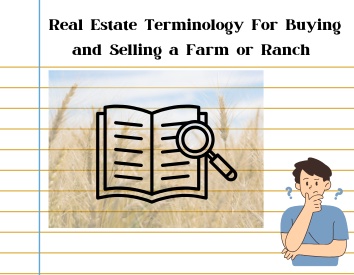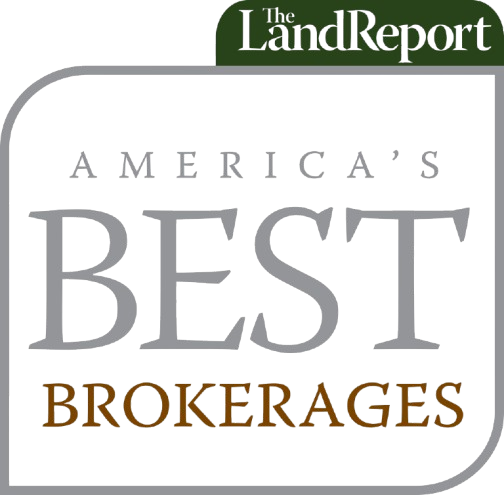When buying a ranch or farm, knowing some real estate terms related to these types of properties is helpful. Understanding these terms can make the process smoother and ensure you’re making informed decisions.
1031 Exchange: Named for its section in the tax code, a 1031 Exchange allows investors to defer capital gains taxes when selling a property and reinvesting the proceeds from the sale within certain time limits in a property or properties of like kind and equal or greater value.
Acre: A unit of land area commonly used in the U.S. and other countries that do not use the metric system. It is equivalent to 43,560 square feet.
Acre-foot (AF): Measurement of the volume of a water flow over time.1 AF = 325,851 gallons
Adjudication: An adjudication is a court action for establishing all existing water rights, resulting in a decree that confirms and defines each water right and protects water users. It establishes the priority date and the amount of water claimed by users for beneficial use.
Agribusiness: A business that earns most or all of its agricultural revenues. An agribusiness tends to be a large-scale business operation and may dabble in farming, processing, manufacturing, and/or the packaging and distribution of products.
Agricultural Easement: A non-possessory interest in land that limits land use for agricultural purposes.
Amendment: A modification or change to an existing document or agreement, often used in real estate contracts.
Animal Unit (AU): A 1000 lb (455kg) cow, either dry or with a calf up to six months, or the equivalent based on a standardized amount of forage consumed. Large herbivores usually consume between 2.0 and 3.0% (dry weight) of their body weight daily.
Animal Unit Equivalent (AUE): The energy requirements of a particular kind or class of animal relative to one AU: Cow with calf= 1 AU, yearling calf= 0.6 AU, Elk = 0.7 AU, Bull, Horse = 1.25 AU, Sheep, mule deer, pronghorn = 0.2 AU.
Animal Unit Month (AUM): The amount of forage consumed by an AU in 1 month. Equivalent to 915 lbs dry weight forage (30 lbs/day *30.5 days/month = 915 lbs). You use AUMs to determine how many animals can graze the allotment for how many months (or weeks or days).
Appraisal: A valuation of property, such as real estate, a business, or an antique, by a professional appraiser.
Arable Land: Land capable of being plowed and used to grow crops.
Basis: Documentation establishing the priority date of a historical water right.
Beneficial Use: Amount of water reasonably needed to accomplish the purpose or purpose of use.
Beneficiary: In the context of real estate, this is the person who receives or will receive benefits from a particular entity (like a will or a trust).
Bushel: A volume unit measuring agricultural produce such as wheat, corn, or beans. A bushel is equivalent in volume to eight gallons.
Capital Gains Tax: This is a tax levied on profit from the sale of property or an investment.
Carrying Capacity: The maximum stocking rate possible without causing damage to vegetation or related resources (i.e., consistent with maintaining or improving range condition or related resources); Used synonymously with GRAZING CAPACITY.
Closing Costs: These are fees and expenses, over and above the property price, that buyers and sellers typically incur to complete a real estate transaction.
Comparable Sales: Often referred to as “comps,” these are recent sales of similar properties in nearby areas that are used to help determine a property’s current fair market value.
Conservation Easement: A type of agreement that limits certain types of uses or prevents development from taking place on the land in perpetuity while the land remains in private hands.
Crop Rotation: Farmers implement crop rotation to enhance soil health and manage pests effectively. For instance, the root structure of a grain crop, such as wheat, resembles that of the grass in your yard, whereas corn has a root system more akin to a carrot or taproot. By planting a variety of crops each year, farmers can also prevent the accumulation of insects and weeds, as different crops attract different pests.
Cubic Feet Per Second (cfs): Measurement of water flow equal to 7.48 gallons per second.
Cultivated Land: Land that has been prepared for crops by tilling or plowing.
Deed: A legal document that represents property ownership.
Deed of Trust: A legal document by which the title to property is transferred to a third-party trustee as security for a debt owed by the borrower.
Down Payment: An upfront payment made when buying property is often expressed as a percentage of the total purchase price.
Dryland Farming: Dryland farming refers to a method of agriculture practiced in arid and semi-arid regions without the use of irrigation. Farmers can cultivate crops without relying on additional water sources by planting drought-resistant crops and employing moisture-retaining techniques. Some common practices include sowing seeds deep in the soil, applying mulch to reduce evaporation, and rotating crops. Each region has specific crops that thrive better than others. As climate change progresses, the significance of dryland farming is expected to rise.
Due Diligence: The research phase before a business transaction where the interested party seeks to understand all risks, liabilities, and potential opportunities. This often involves surveys, inspections, and a title search in real estate.
Easement: A legal right to use another person’s land for a particular purpose. For example, the municipal water company may have an easement to run water lines across private property.
Elements: Parameters of water use that define purpose, amount, when, and where water can be used.
Eminent Domain: The power of a government or its agent to expropriate private property for public use, with payment of compensation.
Equity: The amount of money a property owner would receive if they sold the property and paid off the mortgage.
Existing Water Right: Water right in use before July 1, 1973. Aka, pre-73 or historical right.
Fair Market Value (FMV): The price that a ready and able buyer, not forced to buy, would pay and which a ready and willing seller, not forced to sell, would accept, assuming that both parties are fully informed, act reasonably, and have sufficient time to consider the transaction with due care.
Farm Management: The process of making business decisions about producing and marketing agricultural products.
Gallons Per Minute (gpm): Unit of measurement used to quantify flow rates below 1 cfs.
Grazing Rights: The right to graze livestock on public land.
Hay: A mixture of grass and legumes, like alfalfa. It is most commonly used in two ways: Haylage: the hay is cut, chopped, and stored loosely in a storage silo, while it is still moist. Hay: usually cut after haylage when the plants are taller, it is allowed to dry in the field. It is then baled into round or square bales and stored under cover.
Land Management: Managing land resource use and development (in both urban and rural settings).
Land Tenure: The legal regime in which an individual owns land said to “hold” the land.
Land Use Planning: A planning technique to improve the quality of life in urban and rural settings by influencing the distribution of people and activities.
Legal Description: A written statement recognized by law as to the absolute location and boundaries of a parcel of land.
Limits Or Extent Of A Water Right: The maximum amount of water that can be diverted and used. Or the maximum use of water, e.g., the size of a reservoir or the number of acres irrigated, livestock watered, or homes supplied by a water right.
Miner’s Inches: Historical term for the flow rate in a miner’s sluice. Found in old court decrees. 40 MI = 1 cfs
Operational Description: Operational descriptions are generally more focused on the agricultural activities of a farm or ranch. They feature in-depth details about how the land is managed and insights into the cow-calf operation, such as pasture rotation, weight gain, and shipping schedules. Additionally, irrigation systems are thoroughly examined, covering aspects like pivot ground, flood irrigation, and gravity-fed systems.
Pasture: Land covered with grass and other low plants suitable for grazing animals, especially cattle or sheep.
Phase One Report: A Phase I Environmental Site Assessment is utilized to gather information regarding a property’s environmental condition and identify actual or potential environmental contamination. This process protects both the buyer and the seller. The buyer will learn about any impact on the property value, and the seller will be protected from a possible claim that could occur after the sale has been finalized. In a farm or ranch acquisition, this is a very important step as often there is the use and/or storage of many potentially hazardous materials such as fertilizers, fuel, or propane, as well as agricultural runoff, landfills, etc.
Physical Description: The physical description of a ranch, farm, or recreational property outlines the land’s physical characteristics. This overview can encompass general features such as rolling hills, cropland, wooded areas, landscaped sections, rivers, streams, springs, lakes, and ponds. Additionally, it may provide more specific information about the precise acreage associated with each type of land classification.
PLSS: Public Land Survey System subdivides land into Townships, Ranges, and Sections.
Power of Attorney: A legal document giving one person the power to act for another person; it can offer broad or limited powers.
Proper Use: A degree of utilization of the current year’s growth which, if continued, will maintain or improve the long-term productivity of the site or achieve specific management objectives ( e.g., improve range condition).
Proper Use Factor (PUF, %): An index to the grazing use that may be made on a specific forage species, sometimes referred to as allowable use. (aka allowable use, safe use factor, Harvest coefficient) (e.g., a PUF=35% means that livestock and wildlife can consume 35% of the current season’s growth without damaging the grazing resource, while 65% of the current season’s growth is left untouched).
Purchase Agreement: A legal document outlining the terms and conditions of a real estate transaction between a buyer and seller.
Real Estate Broker: A person representing sellers or buyers of real estate or real property.
Stocking Density: The number of animals per unit area of land at any instant of time.
Stocking Rate: The number of animals grazing or utilizing a unit land area for a specified period, e.g., AU/ac, AUM/ac, AUM/ha, or reciprocal.
Survey: A precise measurement of a property‘s boundaries and land features.
Title: A legal term for an owner’s interest in a piece of property, often evidenced by a deed.
Title Insurance: Insurance that protects the holder from financial loss sustained from defects in a title to a property.
Zoning: A legal mechanism by which local governments control the development and use of land.




